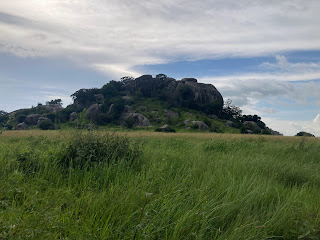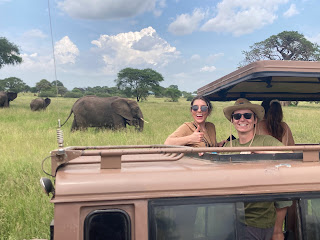January 25th, 2024
We were on the road by 8 am and our first stop was the
Ngorongoro Crater Gate. We wouldn’t be
venturing down into the crater today, but running along the rim of it. This still required a permit of some sort so
while the guides worked on that, the rest of us had a pit stop, checked out the
gift shop and read some information about the history and wildlife of the
area. One thing that I thought was
interesting, was that tracking collars put on cheetahs for scientific research
usually stay on the cat for a year, and then can be remotely detached and then
retrieved. That’s cool.
Approaching the Ngorongoro Gate:
After the gate, the paved roads were a thing of the past and
we wouldn’t experience them again until the end of the safari. About half an hour after the gate, we stopped
at the main viewpoint for the Ngorongoro Crater which was absolutely
stunning. Although it’s called a crater,
it’s technically a caldera. To me, when
I hear crater, I think of an asteroid hitting the Earth and causing a huge
impact area. This, however, was created
by a volcano which essentially imploded, creating a large flat area with a rim
of ridge around it.
Looking down into the crater:
Our group snapped a bunch of photos and broke out a few
pairs of binoculars to see what we could see.
The crater is supposed to be abundant of animals but since the distances
are quite long to the crater floor, the only animal we could pick out were a
few herds of elephants. Through the
binocs I could see their tusks shining in the sun, it looked incredible. I can’t wait to get down there…which will be
on our last of the four-day safari.
Back in the Land Cruisers, we continued along the rim of the
crater, although the road is set back far enough that you can’s see into
it. We pulled into the Simba Campsite,
which would be our home for the following night. The guides wanted to drop some items off here
to free up some space in the vehicles.
The landscape changed from jungle-like to small mountains covered in
grass and we had our first views of the massive savannah plains of the
Serengeti. There were a few Masai huts
dotting the hillside and also a Masai village surrounded by a wall made of
large pieces of wood, obviously meant to keep the wildlife out.
The Serengeti's down there somewhere:
As we descended to the valley, there were some giraffes
eating leaves from Acasia trees near the road, much closer to us than the
couple of giraffes we had seen the day before in Tarangire Park. The Portuguese asked Lewis to stop so they
could pop open the roof and snap some pics.
Reaching the base of the mountain range, we were greeted by the sight of
hundreds of wildebeests and zebras…yup, we have arrived in the Serengeti, which
appropriately means “endless plain” in the Masai language.
We pulled into a rest stop for a bathroom break but there
was a big pedestal with a couple of large replicas of skulls, one of Paranthropus Bolsei
(never heard of it before) and the other of Homo Habilis. The reason they were there is that this area
is considered the “Cradle of Humankind” as fossil remains of both of these
species, dating back almost 2 million years ago, were found here.
Continuing along the fairly straight, bumpy gravel road,
Lewis informed us that we were still in a “conservation area”, which meant the
the Masai people were allowed to graze their goats and cattle amongst the
plethora of wildebeests and zebras.
Eventually we reached a gate and sign that signified that we were
entering the Serengeti National Park and this was the boundary for the Masai
cattlemen.
Our lunch stop in the Serengeti:
Although most of the Serengeti is flat plains, there is the odd rock outcropping or even small hill, which tends to be covered with trees. These are oases for certain animals and they stick out like islands in the vast flatland. The road climbed up one of these hills and there was an official gate for the Serengeti National Park, where the guides had to pay our entrance fees. It was also a good place for us to stop and have lunch, along with many other tour companies.
One of the rocky outcroppings:
Our guide Lewis often had a shortwave radio on, occasionally
chatting with the other guide Max and listening to other guides. It was all in Swahili so I couldn’t
understand what they were talking about however they would announce to one
another if they found some interesting wildlife.
We pulled off of the main road towards a random building in the middle of the plains that had solar panels on the roof but didn’t look to be currently used. Why did we go there? Well, there was a male lion hanging out near the structure, lying down and panting a bit in the late afternoon sun. We snapped a few pics but then both vehicles left the area almost as soon as we had arrived. Why?!? Well Lewis had heard on the radio that a ranger was coming, and we weren’t supposed to be on that side road near that building. Thanks for risking it Lewis!
As the afternoon drew on, we stopped along with half a dozen
other Land Cruisers (Toyota really has this safari business sewn up…it’s pretty
much the only vehicle you see out here).
Everyone was trying to spot a leopard in a tree about 100 meters from
the road. Lewis described where it was
after he looked with the binoculars and I was also able to see it. Philip did too, or at least he thought he did
but none of the other Portuguese members of the group could find it. They were questioning whether there really
was one there. We were starting to pull
away when a second leopard jumped up onto a lower branch and was much more
visible. Sweet.
The leopard is considered one of the Big Five. A lot of people think that the giraffe and
hippo should be in the Big Five before the leopard, but Lewis explained that
the reason that the animals that make up the Big Five (rhino, elephant, lion,
buffalo and leopard) were chosen because they are the toughest to hunt on foot
by big-game hunters. They are sought
after due to their horns or skin.
The last sightings of the day were a herd, or also known as
a “bloat” (sounds very appropriate), of hippos in a small lake and a solo
Marabou stork hanging out at the top of a dead tree.
We arrived at camp which consisted
of three buildings: a bathroom complex, a kitchen and a dining area. Our tents were already set up so once we
settled in, we enjoyed watching the sun set, had dinner and then a relatively
early night as breakfast was to be served at 6 am and we would be heading out
on a game drive around 6:45-7 am.
Me and Selin..happy with the day.
It was a fantastic day in the Serengeti! That night, even though I had earplugs in, I heard some interesting animal noises, most of which I couldn’t figure out. The next morning, Lewis said that he had heard a lot of lions…I’m sure that’s what I heard too…awesome!
















































































